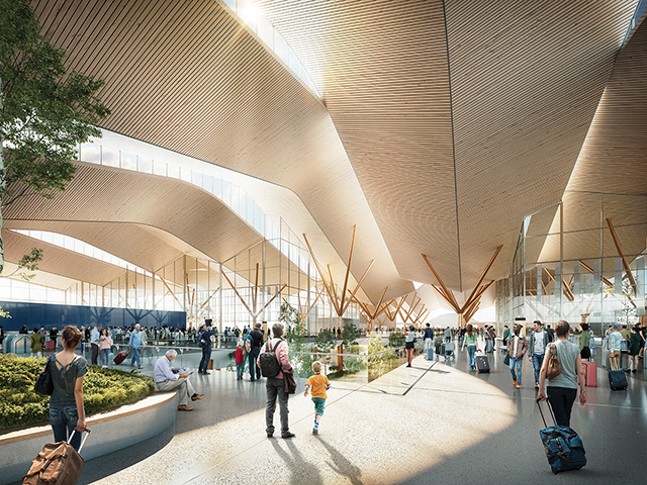The Allegheny County Airport Authority debuted the program design concept for its new terminal on Feb. 20 with an emphasis on NaTeCo – in the press release, in the promotional video, in various comments from designers and clients. The question is not what the word means. It’s a condensation of Nature, Technology, and Community, which the Airport Authority’s marketing processes have determined to be the essence of Pittsburgh, (though the terms might apply similarly to many other places).
The real mystery is why, at the moment of presenting an admirable airport design with notable international pedigree, the Airport Authority is muddying its achievement with insistently local marketing-speak that doesn’t suit the current state of the project.
This is not the first time this has happened.
When the Authority unveiled a conceptual design in 2017, local characteristics were similarly touted, even though what they had was a preliminary planning diagram without a complete design team to produce the actual architecture. Indeed, that scheme has been unceremoniously discarded.
Part of the good news is that the Authority went through an apparently thorough and conscientious architect selection process, something they should have done before debuting any building renderings. They received proposals from 11 teams, then sought further information from a shortlist of four teams.
The team that was selected, announced in July 2018, includes architects Gensler and engineers HDR, with Luis Vidal + Architects as consultants producing conceptual designs. The group has some local connections but is more notable for international experience.
While Gensler, with 46 offices worldwide, is known in Pittsburgh for the Tower at PNC Plaza, its airport design group produced Korea’s Incheon International Airport as its showcase design and has completed numerous aviation projects at small regional airfields and major international hubs. HDR is an Omaha-based engineering firm with over 10,000 employees in 200 offices, including one in Pittsburgh. While boasting experience on Pittsburgh’s own Greenfield Bridge, HDR has completed projects at Honolulu International Airport and Terminal 1 at Fort Lauderdale-Hollywood International Airport. HDR aviation director Bill Peduzzi is a lifelong Pittsburgher.
Especially relevant to the project’s visual character is Luis Vidal + Architects. Madrid-based with several international offices, Vidal’s firm has no promoted Pittsburgh connection, but that hardly seems to hurt its qualifications. The firm designed Terminal 2 at London’s Heathrow Airport and Vidal himself worked on Terminal 4 project at Madrid-Barajas Airport in Spain, by Estudio Lamela & Rogers Stirk Harbour + Partners. Vidal’s firm has several airport projects in design or nearing completion. Notable among them is the Zaragoza Airport, a small regional airport commissioned as a result of a winning competition design in 2005.
Zaragoza seems like a smaller scale precedent to the current Pittsburgh proposal, with regularly undulating ribbons of roof in rhythmic offsets to each other, creating blade-like clerestory openings and suggesting a landscape of rolling hills. The general motif, which also appears in a few developing Vidal projects, is well-suited to hilly Western Pennsylvania, but it is necessarily enlarged in scale for the current scheme. Award-winning Heathrow 2 is suitable in scale compared to Pittsburgh, but it’s a bit too buttoned-down in its regular profile. Madrid-Barajas is beautiful, but maybe a bit too sensual and curvaceous for straightforward Western Pennsylvania.
So the current scheme anticipates better-engineered construction than the original Zaragoza scheme–broader, airier spans, with less of a nuts and bolts sensibility. Pittsburgh’s columns branch out toward the tops to become more tree-like, reiterating nature with formal directness. Perhaps Gensler, adapting from its proposal for an airport in Mexico City, believes that Pittsburgh’s roofs can be more ribbon-like than the metal framed counterparts at Zaragoza.
Months-long design processes of complex buildings are far more complicated than a few image comparisons. Force-feeding a local message on a project in a moment of exciting global relevance seems like a marketing error for a project whose considerable complexities seem to be in technically and artistically capable hands.
Giving the terminal a flavor of Pittsburgh is eminently possible, but the architectural decisions on things such as views and outdoor spaces are further down the Gantt chart from where we are now. Decisions such as selection of vendors and the all-important public art will have an especially resonant effect on local identity.
When those issues reach their phases of peak relevance, we can only hope that they are marketed with more sympathy and insight than the international architecture has received at this highly relevant but oddly under-appreciated stage.
















